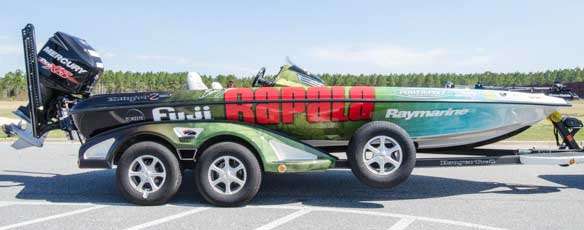
Each year about this time, touring pros begin the process of selling their boats. We do this in order to move into next year’s models. Some might consider this part of the spoils of being a pro angler, and in some ways it is. But in most cases it’s a requirement.
Sponsors expect us to showcase their latest equipment, and that includes everything from the basic hull to any added options and accessories, such as electronics. And while the prospects of getting a new boat may sound exciting, it actually requires considerable effort. Here’s why:
Before ordering a new boat, there’s the task of selling the current one. And that’s not always easy … especially in a down economy. Factor in hunting season — a period when many would-be boat buyers are spending their time and money in the woods — and the task gets even tougher.
The truth is, not all of us want to move out of our current rigs anyway. About the time we get comfortable with a boat’s setup, it’s time to sell and begin the process all over again. To keep our sponsors smiling, however, these boat must sell … and here’s the routine most of us follow in order to make that happen.
Wrap On, Wrap Off
The first order of business is wrap removal. Any potential buyer will want to see a boat’s true colors and condition before negotiations ever begin. That’s a given.
Colors are important, too. They can often make or break the deal — no matter how good the rest of the package may look. That’s one reason I order predominantly black, white and silver color packages — neutral colors like these match the most commonly owned tow vehicles (black, white, or some shade of gray).
Besides touting our sponsor’s logos, boat wraps also protect the boat’s finish. So well, in fact, once removed, the boat should look like the day it came out of the mold. And that obviously helps on resale.
The only difficult part of wrap removal is eliminating any areas of surplus glue. The factory adhesives used on quality films aren’t the problem, it’s the added glue installers apply to areas of high stress — so that a wrap can endure the rigors of extended exposure under extreme conditions.

Whether I remove it myself or leave the job to the guys that wrap my boats (WrapThisInk), it usually takes a full day to complete the process.
Cleanup & Maintenance
Once the wrap is off, the boat is then cleaned thoroughly. I always power wash or steam clean the carpet, then go through and polish everything, including the insides of the compartments. I want the boat to look like new, and it’s this attention to detail that has helped me sell all of my boats throughout my career.
Besides detailing the boat, I also perform a final maintenance procedure. That includes inspecting all the mechanical equipment in and outside the boat — including the outboard, trolling motor, electronics and trailer. That means lubricating the engine’s lower unit, trailer hubs and going through the braking system. Tires, too, get balanced and rotated.
In all, it takes a few days to have the rig fully prepared for resale.
Boats 4-Sale
In most instances, my boats are sold before the season ends. Word of mouth through previous buyers accounts for some of that, but there have been times when a co-angler or Marshal purchased my boat. My Ranger dealer, too, has helped me with securing sales.
When there’s no buyer on the line, I rely on social media or various websites to help get the word out. Facebook, Bass Boat Central and Boat Trader are all great places to advertise a boat. All that’s required, really, are some photos and an itemized description of the boat’s options and accessories. Put those together with the right price, and a buyer is usually only a phone call away.

In selling any used boat, the bottom line is offering value to the next guy. Extended warranties help, but even a lifetime warranty isn’t likely to affect resale as much as having a clean, well-maintained, color-matching package.
So if you’re in the market for a slightly used boat, you might consider purchasing a pre-owned tournament boat. Yeah, a few get punished during the season, but most are well maintained and in really nice shape, and they usually have plenty of warranty left over.
You can expect to pay about 75 percent of retail for a year old tournament boat, and in times like these, that’s a pretty good savings — especially considering how much tackle that extra money can buy!
Follow Bernie Schultz on Facebook or through his website.





